JUMP CUT
A
REVIEW OF CONTEMPORARY MEDIA
![]()

33. Michael Ruppert: his compelling study of the age of "peak oil" has a conservative strain.


34. Zwicker interviews Ruppert in The Great Conspiracy: investigation as media phenomenon.


35. Rebuilding America’s Defenses: Strategy, Forces and Resources for a New Century: a key document of the Project for a New American Century

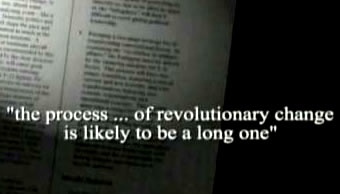
36. A phrase from PNAC that is...

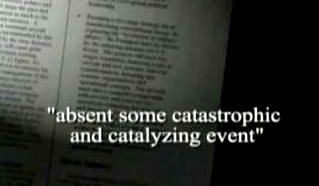
37. ...a call to arms for the Truth Movement


38. Bush and Wolfowitz: the ideology of the Bush regime is informed by PNAC.

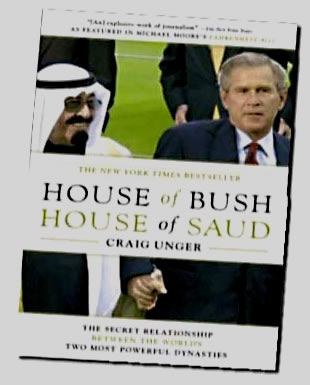
39. The relation beween the Bush family and the House of Saud is the least contentious although largely forgotten point of 9/11 research.


40. Alex Jones: conservative populist, key figure of the Truth Movement

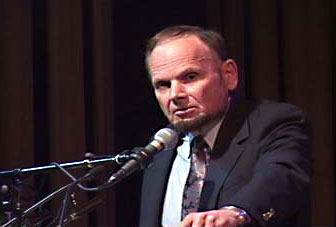
41. Ralph Schoenman: his is thus far the only radical analysis of 9/11.

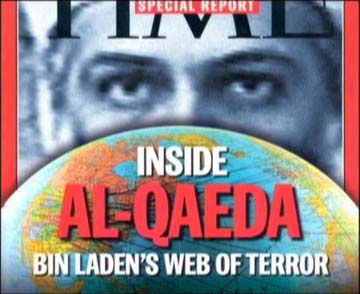
42. Osama bin Laden: constructed boogeyman, intelligence asset, religious fanatic, billionaire. His role has not been carefully studied by the Truth Movedment.

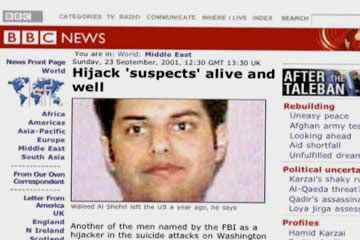
43. International media reported some hijackers alive and well.


44. Mohamed Atta under surveillance on 9/11.


45. Mohamed Atta: 9/11 ringleader and religious fanatic who loved liquor, lap dances, and a high public profile.


46. Paul Thompson: 9/11 media researcher par excellence


47. Bin Laden? From VHS tape found in Afganistan


48. Will the real bin Laden please stand up?


49. From 9/11 Eyewitness: microanalysis may be the strength and weakness of the Truth Movement.

Operation Northwoods, to the 9/11 Movement, doesn’t provide a precedent for official turn-of-the-head approval. But it stands as key evidence of how the state apparatus can conceive of a murderous operation stopped at the last minute only by the pragmatic common sense of top rulers, an element perhaps missing from the months leading to 9/11. Indeed, for those who think that a 9/11 conspiracy is too arcane and baroque, the Northwoods documents are instructive, including complex plans for the use of substitute aircraft, substitute passengers, and James Bond-ish cover stories. These documents are like cold water in the face of conspiracy debunkers who argue that such plots are beyond the thinking powers of state authority. That Operation Northwoods was stopped is something of a miracle; it was “leaked” almost a half-century later by a diligent researcher whose work received almost no attention from the mass media. Zwicker remarks that if 9/11 wasn’t a planned, provocative incident used to instigate war, it was an exception to the rule.
Michael Ruppert’s The Truth and Lies of 9/11 goes into NORAD non-action, ignoring entirely arguments about the WTC attack as controlled demolition. Ruppert’s (Fig. 33) video is a recording of his 2002 lecture at Portland State University, with a few rather random observations by Peter Dale Scott (who edited an edition of the Pentagon Papers) (Fig. 34) interspersed. Since it is a taped lecture, Ruppert’s is among the most static of the 9/11 films, his presentation lacking the fire of Schoenman’s Underlying Politics of 9/11. Ruppert, a former LAPD cop, follows the lead of Michael Moore’s Fahrenheit 9/11 by emphasizing the relationship of the Bush family to the House of Saud and the Bin Laden family, among the least controversial of all 9/11 assertions. Shown flipping transparencies of documents on an overhead projector while warning he will “rock your socks,” Ruppert seems overly impressed with his own style, causing one to pause a bit in evaluating him. For the most part his assertions are only moderately contentious; more controversy may come from his neo-Malthusian worldview and conservative survivalist politics. Ruppert argues that U.S. rulers realize we have reached “peak oil,” causing them to extend panicked authority over fossil fuel resources. (Fig. 34) The age of oil is winding down, but this reductive view ignores the oil industry's whatever-the-market-will-bear price-gouging and its capping wells to drive up anxiety and prices. Like most of the 9/11 researchers, Ruppert ignores some basic dynamics of capitalism. (Fig. 35), (Fig. 36) (Ruppert’s favorite target is actually Zbigniew Brzezinski, Carter’s national security advisor, whose book The Grand Chessboard expresses concern over the world slipping from U.S. hegemony), but one could look to the Truman era (or Eisenhower, or Kennedy, or Johnson, or Nixon…) It is useful to note the plans of the Project for The New American Century for ruminations over the terrible threats posed to U.S. authority. (Fig. 37), (Fig. 38) The PNAC remarks there's a need for a “catalyzing and catastrophic event…like a new Pearl Harbor,” and so provides a portentous ideological statement insistently cited by the Movement. Setting catastrophe in motion may indeed be a way by which authorities foment (Fig. 39) inter-imperial rivalry, but that idea is familiar to anyone with a knowledge of U.S. expansionist ambitions since at least the early twentieth century.
The fuzzy-minded or flatly absurd politics of some of the 9/11 researchers present real challenges in Alex Jones’s 9/11: The Road to Tyranny. Jones, a popular Austin radio (Fig. 40) host with a twangy, rapid-fire, dripping-with-sarcasm delivery, is by far the most entertaining of the 9/11 documentarians if one can get past his rightist libertarianism, a daunting task. Jones is an on-camera, in-your-face presence, conducting man-on-the-street interviews with much more media savvy and personal charisma than his younger, less than debonair 9/11 researcher-colleagues. He may also be the poster boy for leftist cautions about conspiratorial thinking. Although Jones has a contempt for the Bush regime and shares with other 9/11 critics the view that the attacks constituted a staged incident, he sees the event as but one episode in the construction of the New World Order, a phrase used repeatedly by George Bush I at the height of post-Cold War triumphalism that well serves Jones’s anti-left views.
Jones’s thinking isn’t too far from Gary Allen’s infamous John Birch tract None Dare Call it Conspiracy, where banking interests share common cause with socialists in creating a master plan to enslave humanity. Jones is outspoken on a number of important human rights issues, but his real enemy is Big Government’s attack on Christian Civilization, and its seemingly ultimate project of forging a One World dystopia of drug-addled automatons. Jones’s enemies list is substantial, ranging from the real plotters behind the Oklahoma City bombing (about which he offers some interesting material culled from local media) to implanted microchips to the health-endangering sweetener Aspartame. Each one of Jones’s topics is worthy of close analysis, but each gets lost in his blizzard of tabloid-show images and yahoo tirade.
But it would be a mistake to dismiss Jones and his large audience as people who, in Chomsky’s words, are concerned with everything except what’s important, representing not just the limits but the tomfoolery of conspiratorial thinking. Jones’s work is often confused and confusing — in this he may well represent the U.S. mind in the early twenty-first century. Although his anxieties are free-floating and grounded in little economic analysis, they are nevertheless authentic enough, speaking to a political and economic disempowerment that has made the population vulnerable to all sorts of ahistorical analysis. Whether Jones merely partakes of this problem or capitalizes on it is less relevant than our need to build political coalitions that include this understandably angry audience.
Alex Jones' questionable political analysis points to an old problem of conspiracy research already affecting the 9/11 Truth Movement. Like the assassination research movement of the last century, 9/11 Truth is splitting into not-so-cordial factions. The process may either help clear the air or damage the cause. Eric Hufschmid, whose Painful Deceptions is one of the foundational videos of the Movement, has a noxious website wherein he questions the Holocaust, refers to the general population as “sheeple” (dumb beasts being helped along by enlightened people like him), and the slave trade as a means by which African nations freed themselves of their “retards and idiots.” As researchers overturn or seriously challenge assertions about missiles hitting the Pentagon and black, pod-bearing airplanes striking the WTC, concern grows about the Movement being discredited by irresponsible claims or amoral political worldviews. (Fig. 41) The only radical analysis thus far of 9/11 as government operation is Ralph Schoenman’s The Underlying Politics of 9/11. Schoenman, host of the syndicated radio show Taking Aim, was secretary to Bertrand Russell in the 1960s, and executive director of the Bertrand Russell Peace Foundation. His fifty-year radical activism has included service on the Russell-sponsored tribunal on war crimes in Southeast Asia,study of the JFK, RFK, and King assassinations, and advocacy of prisoners’ rights. His articulate, stem-winding style is refreshing in the context of the amateur narrations and weak political focus of many of the 9/11 videos. Schoenman suggests we shouldn't “reinvent the wheel” when approaching 9/11. It is, to his thinking, not a strange bolt from the blue but business as usual for the U.S. ruling class as it pursues its aims.
So what of Osama bin Laden and Al Qaeda? In general, the 9/11 videos argue that (Fig. 42) bin Laden is the archetypal bogeyman used with regularity to focus hatred on the Middle East and elevate public fear. Most videos note that no real evidence was adduced proving bin Laden actually perpetrated the crimes — his earliest cable on the subject professed innocence. The 9/11 Commission concluded that tracing the funding of the attacks was impossible and probably unimportant (!). Since the Bush government refused from the outset to view 9/11 as a criminal act, preferring warfare against states rather than analysis of the relevant data followed by prosecution, it may be decades before we get a clear picture of Al Qaeda's role. But this area isn’t neglected by the 9/11 videos.
Many of the videos note anomalies regarding the nineteen purported hijackers. The international media, including BBC online, reported at least several of the men, including (Fig. 43) accused ringleader Mohamed Atta, alive and well in various parts of the Middle East following 9/11. An Oct. 10, 2001 Boston Herald account has Atta raving it up in Florida bars prior to 9/11, drinking liquor, enjoying lap dances, using profanity, and otherwise drawing attention to himself, hardly the behavior of a devout Muslim involved in a monumental clandestine terror operation fueled by a strict religionist ideology. (Fig. 44) One video available on the web, Mohamed Atta and the Venice Flying Circus, also notes the apparent connection to the intelligence community of the Florida flight schools (Fig. 45) briefly patronized by Atta and friends. Stories about Atta and colleagues are collated by Paul Thompson, whose massive book The Terror Timeline may be the single most useful research tool on 9/11. He is featured in Zwicker’s The Great Conspiracy and 9/11: Press for Truth.
Thompson is the Internet researcher par excellence. He has culled hundreds of news stories about 9/11 from the mainstream media, showing, through the simple process of recovering and printing the accounts, that all is not well with the official narrative. The story of strip-joint loving fundamentalist Muslims is disturbing enough. Thompson notes (Fig. 46) a Miami Herald story that has Atta getting into a pointless scuffle over a parking slot at Logan Airport the morning of the hijackings. Police let him go when they discovered a pass giving him access to secured areas at Logan. Even more astounding is a Gannett News Service story covered by Thompson that quotes an Air Force source on Mohamed Atta’s education at the International Officer’s School at Maxwell Air Force Base. The role of Al Qaeda in 9/11 is murky, but perhaps not unfamiliar to those who remember accounts of lone nut Lee Harvey Oswald drawing attention to himself at used car dealerships and gun ranges, studying at the Defense Language Institute, or carrying a privileged military I.D. card at his arrest in Dallas. Such scenarios have recurred in state operations with some regularity as attempts to deflect attention from the nature of an operation by placing the purported perpetrator squarely, if clumsily, in the foreground.
Avery takes on the famous VHS tape found in Afghanistan after the U.S. attack, showing bin Laden relaxing with several other men, and virtually bragging about the (Fig. 47) attacks (depending on which translation you heard/read). Avery claims that the man in the blurry tape resembles bin Laden only superficially. The man has smaller features, a fuller face, wears a gold ring on his right hand (bin Laden doesn’t wear jewelry) and uses his right hand to write, although a CIA profile has him as left-handed. Neither Avery nor any other 9/11 videographer asks the crucial questions as to how and under what precise circumstance the tape was found, a singularly crucial piece of evidence in the blighted (Fig. 48) ruins of that bombed-out land. Alex Jones and Zwicker note, joining ranks with non-conspiratorialists of the left like Michael Parenti, bin Laden’s long term relationship with the CIA as a key leader of the mujahideen as the U.S. prepared, in Zbigniew Brzezinski’s words, an “Afghan trap” for the Soviet Union in the late 1970s. Bin Laden was crucial to the U.S.-funded war against the crumbling Soviet Union in the 80s war in Afghanistan.
An Al Qaeda plot and one involving the U.S. government aren’t mutually exclusive, although this scenario isn’t fully entertained by the Truth Movement videos. If one sees bin Laden less as a zealous Arab freedom fighter and more as an intelligence functionary and reactionary scion to a fabulously wealthy family, it is not beyond reason that his organization assisted its imperialist friendly rivals in a spectacular event that has furthered state power East and West, at least for the nations given the seal of approval by the U.S. The 9/11 videos tend not to think through such a scenario, opting more for a plot in which the U.S. is the guiding and mostly unassisted agent, or else merely posing unanswered questions about Al Qaeda's role. And few of the DVDs look at Al Qaeda as prime mover, with the U.S. waiting on the sidelines.
For those who don’t have the time or inclination to sort through all of the arguments of each 9/11 video, several discs have been released functioning as compilations of the most important points, including A Call to Reopen the Sept. 11 Investigation: Confronting the Evidence, a three-hour compendium assembled by businessman Jimmy Walter. It is reasonable to say that this disc is a one-stop-shopping introduction to the basic arguments of the Movement. Dustin Mugford’s September 11 Revisited opens with a stunning montage of as-it-happened media comments on the twin towers’ collapse — Dan Rather and Peter Jennings note the resemblance of the destruction to controlled demolition. Aftermath: Unanswered Questions From 9/11 is a perhaps too-slim overview, published by Disinformation, the popular imprint that issues Robert Greenwald’s films and Greg Palast’s important Bush Family Fortunes. Perhaps most impressive of all the compilation videos is 9/11 Mysteries, free on the web, whose unassuming title belies its highly methodical, detailed examination of the attacks and the physics of the WTC collapse. With its calm narration, detailed writing, period footage, and superb research and graphics, 9/11 Mysteries is essential for beginning students of the case, and may well become the most historically significant document refuting the official fiction. Michael Berger’s Improbable Collapse: the Demolition of Our Republic is more or less on equal footing with 9/11 Mysteries, with more dramatic use of score and tighter editing.
As this writing, 9/11 documentaries keep arriving. The most impressive work of the moment is Ray Nowosielski’s 9/11: Press for Truth, which is part tribute to the courage and indefatigable truthseeking of four 9/11 widows, the so-called Jersey Girls (terribly maligned by the repugnant Ann Coulter), and part introduction to the work of Paul Thompson. Although the two components aren’t very well sutured together, this video's quiet, thoughtful tone makes it palatable to a wide audience, offering an invitation to further research. Several new videos refine the scientific work of Steven Jones and Kevin Ryan. Richard Siegel’s remarkable 9/11 Eyewitness renders in almost (Fig. 49) eye-glazing detail the dynamics of the WTC collapse, making effective use of mathematical computations, physics formulae, and a digital stopwatch used as overlay on the image of the twin towers as they fall. This video is indeed startling: digital enhancement of news footage shows numerous small, fireworks-like explosions as the towers come down. This and other ongoing research make far less tenable the argument that the large jets of debris shooting out from the towers as the collapse happened were caused merely by air pressure in the upper floors.
The phenomenon of the Truth Movement sparks hope in a revival of sixties-style popular resistance, especially if one sees it coupled to the general discontent over the Bush doctrine and its disastrous foreign and domestic consequences. But looks are usually deceiving. Korey Rowe, Dylan Avery’s partner in the Loose Change project, has remarked that 9/11 is “our Kennedy assassination,” meaning, I assume, that September 11 is a watershed moment that defines a generation. Rowe’s comparison invites noting significant differences between these two events, their political implications, and involvements in their respective historical moments.
The Kennedy murder was internecine conflict within the power structure that had little relevance to antiwar activism of the Vietnam era even as it generated numerous books and articles. It became a locus of activism after the fact, as Watergate signaled to the youth movement a need to look critically at state crimes. 9/11, if state-sponsored criminality, is manifestly worse, since thousands were murdered as a preamble to U.S. foreign aggression. Although one doesn’t need to see 9/11 as state-instigated action to understand its awful use as such a rationale, proving it to be such obviously adds a dimension to state criminality that could have a critically important political function. Korey Rowe’s remark, especially considering his video's thin political analysis, looks like the anguished pursuit of existential meaning upon which liberalism has recently fixated and which is a substitute for the struggle for social and economic justice (the “politics of meaning” was in vogue during the Clinton years). The pursuit is understandable, since recent generations (designated “X” or “Y” or whatnot by the media) have been consigned to throwaway status by neoconservative capitalist civilization, as the educational system disintegrates, jobs are exported, and the young are burdened with an impossible debt while deprived of support systems.
But the research of state crimes solely as a pursuit of identity (if this is the intent) seems a foolish project. The study of the Kennedy assassination indeed shares with 9/11 research similar deficiencies. Conspiracy theorists then and now assume that the possession of special knowledge, even when this knowledge becomes widely accepted, offers itself a pathway toward human liberation. Of course, many students of political conspiracy, as some on the left observe, have little or no political commitment. Revelations about what happened to the Kennedys (or King, or Malcolm X, or the Black Panthers — one can fill in a name) had small galvanizing effect that worked toward mass mobilization. Research and public presentation about individual state crimes can have a political function only in the context of a highly charged moment, such as the discontent of the post-Vietnam years, but even here the positive political effect of conspiracy research was fleeting. Left-oriented students of the Kennedy and King assassinations hoped that an issue-oriented public would see the state murder of charismatic leaders as a flashpoint for public activism as Vietnam and Watergate faded from view. But these murders, as riveting as their stories may be, never fully took hold for the working- and middle classes as emblems of a greater discontent, in part because the left of the Sixties failed to connect with the working class in the first place.
This is not to debunk such study. The analysis of 9/11 will be especially important if melded with resistance to political-economic assumptions that are hardly unique to the Bush era. Even if this fails to happen, the study of the crime is entirely legitimate. We need open and candid public discourse at a time when it is threatened by government and private sector authority, and some knuckle-rapping liberals. The 9/11 Truth Movement, with its abundant information via videos, Internet, and books, is occurring at the same moment that numerous antiwar and social justice organizations respond to the miseries imposed by the Bush era, giving the Movement a complexion and context never enjoyed by the research movements of the past. Combining an understanding of state violence with a sense of its role in capitalist United States was the real purpose of left-leaning conspiracy research of the 60s and 70s, which hoped to place its work in the service of a structural understanding of the order of things. The 9/11 activists and documentarians, with their deft proficiency with the new media, have the potential to accomplish goals lost on previous generations. If they do, they will achieve an identity that will be meaningful indeed.
To
top![]() Print
version
Print
version![]() JC 50
JC 50 ![]() Jump
Cut home
Jump
Cut home

This work is licensed under a Creative Commons Attribution-NonCommercial-NoDerivs 2.5 License.